2018 PEUGEOT EXPERT steering
[x] Cancel search: steeringPage 183 of 416
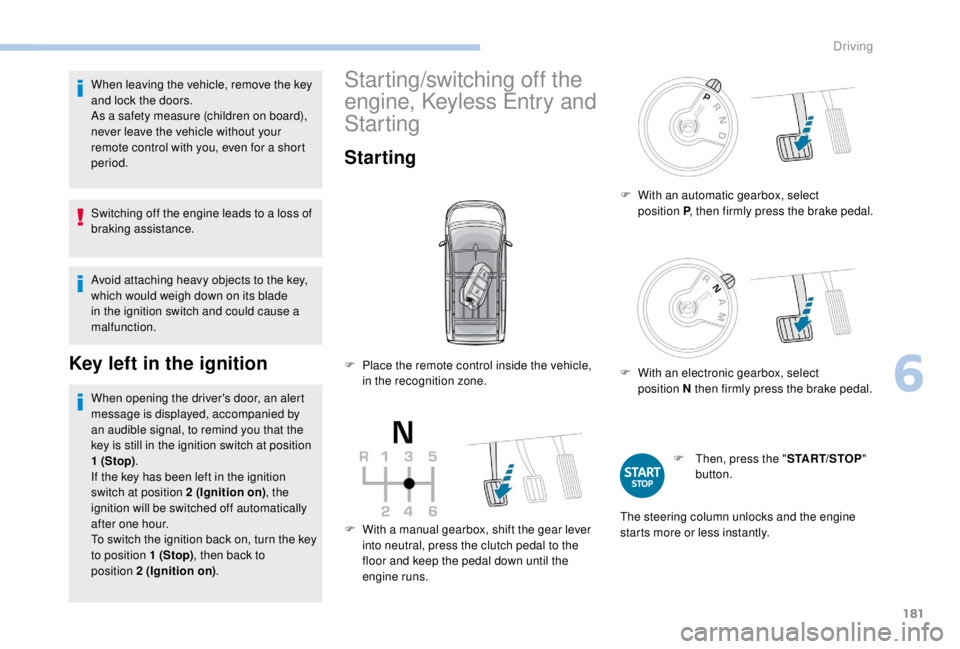
181
When leaving the vehicle, remove the key
and lock the doors.
As a safety measure (children on board),
never leave the vehicle without your
remote control with you, even for a short
period.
Switching off the engine leads to a loss of
braking assistance.
Avoid attaching heavy objects to the key,
which would weigh down on its blade
in the ignition switch and could cause a
malfunction.
Key left in the ignition
When opening the driver's door, an alert
message is displayed, accompanied by
an audible signal, to remind you that the
key is still in the ignition switch at position
1
(Stop) .
If the key has been left in the ignition
switch at position 2
(Ignition on), the
ignition will be switched off automatically
after one hour.
To switch the ignition back on, turn the key
to position 1
(Stop), then back to
position 2
(Ignition on) .
Starting/switching off the
engine,
K
eyless Entry and
Starting
Starting
F With a manual gearbox, shift the gear lever
into neutral, press the clutch pedal to the
floor and keep the pedal down until the
engine runs. F
W
ith an automatic gearbox, select
position P, then firmly press the brake pedal.
F
W
ith an electronic gearbox, select
position N then firmly press the brake pedal.
F
T
hen, press the "
START/STOP"
button.
F
P
lace the remote control inside the vehicle,
in the recognition zone.
The steering column unlocks and the engine
starts more or less instantly.
6
Driving
Page 184 of 416
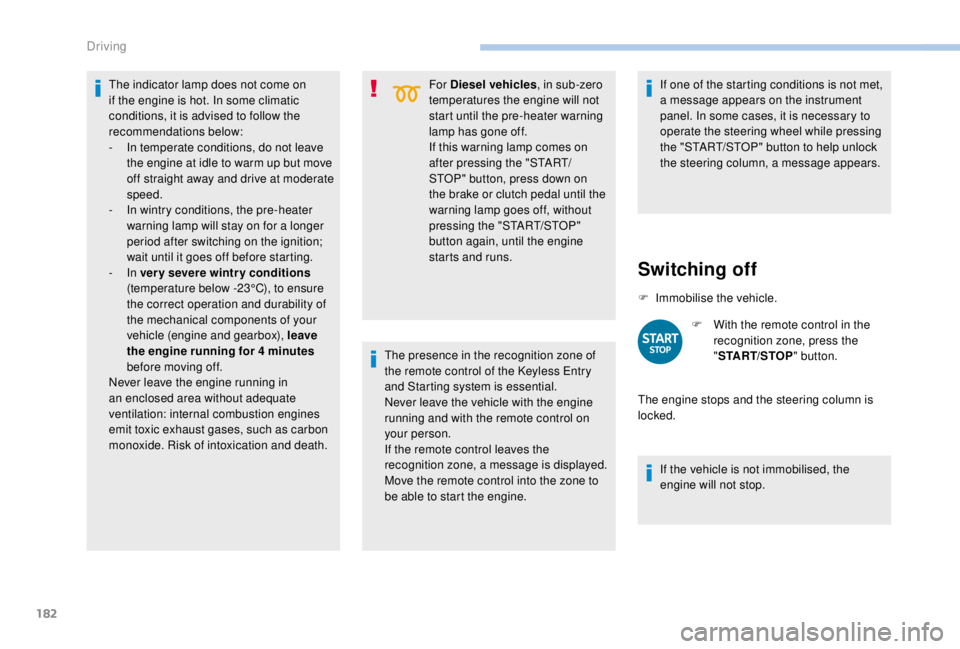
182
The indicator lamp does not come on
if the engine is hot. In some climatic
conditions, it is advised to follow the
recommendations below:
-
I
n temperate conditions, do not leave
the engine at idle to warm up but move
off straight away and drive at moderate
speed.
-
I
n wintry conditions, the pre-heater
warning lamp will stay on for a longer
period after switching on the ignition;
wait until it goes off before starting.
-
In very severe wintry conditions
(temperature below -23°C), to ensure
the correct operation and durability of
the mechanical components of your
vehicle (engine and gearbox), leave
the engine running for 4
minutes
before moving off.
Never leave the engine running in
an enclosed area without adequate
ventilation: internal combustion engines
emit toxic exhaust gases, such as carbon
monoxide. Risk of intoxication and death. For Diesel vehicles
, in sub-zero
temperatures the engine will not
start until the pre-heater warning
lamp has gone off.
If this warning lamp comes on
after pressing the "START/
STOP" button, press down on
the brake or clutch pedal until the
warning lamp goes off, without
pressing the "START/STOP"
button again, until the engine
starts and runs.
The presence in the recognition zone of
the remote control of the
K
eyless Entry
and Starting system is essential.
Never leave the vehicle with the engine
running and with the remote control on
your person.
If the remote control leaves the
recognition zone, a message is displayed.
Move the remote control into the zone to
be able to start the engine. If one of the starting conditions is not met,
a message appears on the instrument
panel. In some cases, it is necessary to
operate the steering wheel while pressing
the "START/STOP" button to help unlock
the steering column, a message appears.
Switching off
F Immobilise the vehicle.
F
W
ith the remote control in the
recognition zone, press the
" START/STOP " button.
The engine stops and the steering column is
locked.
If the vehicle is not immobilised, the
engine will not stop.
Driving
Page 185 of 416
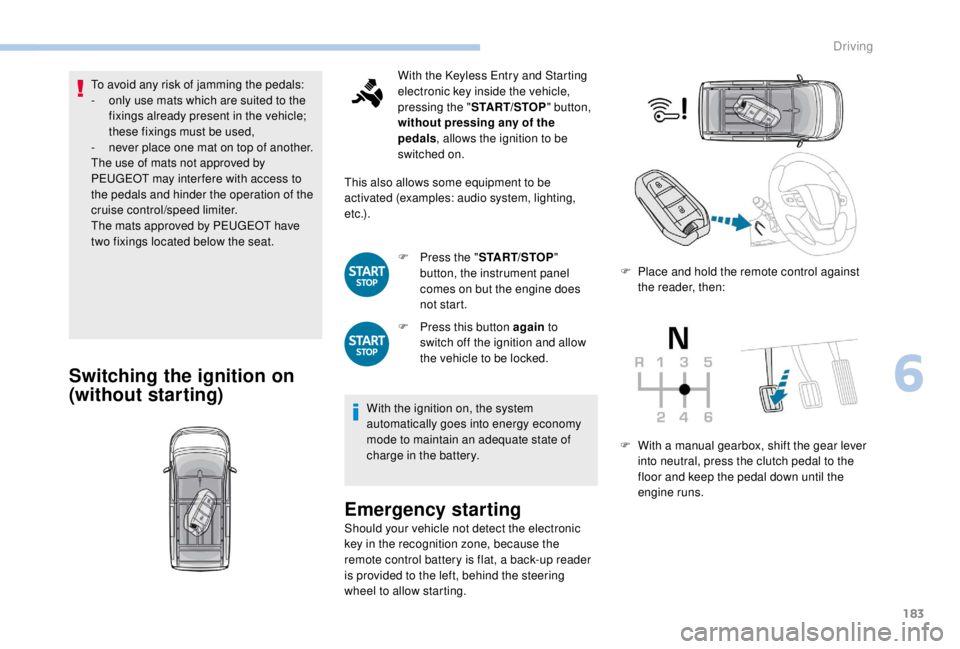
183
To avoid any risk of jamming the pedals:
- o nly use mats which are suited to the
fixings already present in the vehicle;
these fixings must be used,
-
n
ever place one mat on top of another.
The use of mats not approved by
PEUGEOT may inter fere with access to
the pedals and hinder the operation of the
cruise control/speed limiter.
The mats approved by PEUGEOT have
two fixings located below the seat.
Switching the ignition on
(without starting)
With the Keyless Entry and Starting
electronic key inside the vehicle,
pressing the " START/STOP " button,
without pressing any of the
pedals , allows the ignition to be
switched on.
This also allows some equipment to be
activated (examples: audio system, lighting,
e t c .) .
F
P
ress the " START/STOP "
button, the instrument panel
comes on but the engine does
not start.
F
P
ress this button again to
switch off the ignition and allow
the vehicle to be locked.
With the ignition on, the system
automatically goes into energy economy
mode to maintain an adequate state of
charge in the battery.
Emergency starting
Should your vehicle not detect the electronic
key in the recognition zone, because the
remote control battery is flat, a back-up reader
is provided to the left, behind the steering
wheel to allow starting. F
P
lace and hold the remote control against
the reader, then:
F
W
ith a manual gearbox, shift the gear lever
into neutral, press the clutch pedal to the
floor and keep the pedal down until the
engine runs.
6
Driving
Page 186 of 416

184
F With an automatic gearbox, select position P, then firmly press the brake pedal.
F
W
ith an electronic gearbox, select
position N then firmly press the brake pedal.
F
P
ress the "START/STOP"
button.
The engine starts.
Forced switch-offIn the event of an emergency only and with
the vehicle stationary, you can switch off the
engine.
Remote control not
recognised
If the remote control is no longer in the
recognition zone when you close a door or
when you (later) request switching off the
engine, a message appears in the instrument
panel. F
T
o do this, press and
hold the "START/
STOP" button for about
3
seconds.
In this case the steering column locks as soon
as the vehicle stops. F
I
f you want to force
switching off the
engine, press and
hold the "START/
STOP" button for about
3 seconds, then contact
a PEUGEOT dealer or a
qualified workshop.
Driving
Page 191 of 416
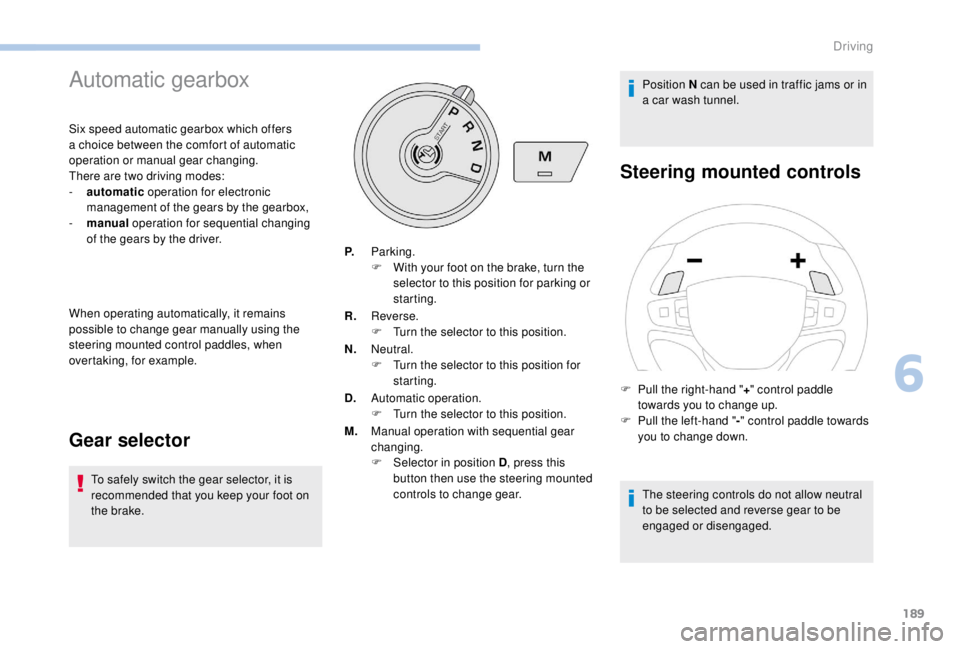
189
Automatic gearbox
Six speed automatic gearbox which offers
a choice between the comfort of automatic
operation or manual gear changing.
There are two driving modes:
-
a
utomatic operation for electronic
management of the gears by the gearbox,
-
man
ual operation for sequential changing
of the gears by the driver.
When operating automatically, it remains
possible to change gear manually using the
steering mounted control paddles, when
overtaking, for example.
Gear selector
To safely switch the gear selector, it is
recommended that you keep your foot on
the brake. P.
Parking.
F
W
ith your foot on the brake, turn the
selector to this position for parking or
starting.
R. Reverse.
F
T
urn the selector to this position.
N. Neutral.
F
T
urn the selector to this position for
starting.
D. Automatic operation.
F
T
urn the selector to this position.
M. Manual operation with sequential gear
changing.
F
Sel
ector in position D
, press this
button then use the steering mounted
controls to change gear. Position N can be used in traffic jams or in
a car wash tunnel.
Steering mounted controls
F Pull the right-hand "
+" control paddle
towards you to change up.
F
P
ull the left-hand " -" control paddle towards
you to change down.
The steering controls do not allow neutral
to be selected and reverse gear to be
engaged or disengaged.
6
Driving
Page 193 of 416

191
If your vehicle has an automatic gearbox,
never try to start the engine by pushing
the vehicle.
Automatic operation
F Select position D for automatic
changing of the six gears.
The gearbox then operates in auto-adaptive
mode, without any inter vention on the part
of the driver. It continuously selects the most
suitable gear according to the style of driving,
the profile of the road and the load in the
vehicle. For maximum acceleration without
touching the selector, depress
the accelerator fully (kick-down).
The gearbox changes down
automatically or holds the gear
selected until the maximum engine
speed is reached.
When braking, the gearbox changes down
automatically to provide effective engine
braking. Never select position N while the vehicle
is moving.
Never select position P or R unless the
vehicle is completely stationary.
Temporary manual control
of gear changes
You can temporarily take over control of gear
changes using the "
+" and " -" steering mounted
controls. If the engine speed allows, the gear
change is carried out. For better safety, the gearbox will not shift up if
you release the accelerator sharply. This function allows you to anticipate certain
situations, such as overtaking another vehicle
or approaching a bend in the road.
After a few moments with no action on the
control paddles, the gearbox returns to
automatic operation.
Self-sufficient traction
(moving without using the
accelerator)
This function facilitates manoeuvring of the
vehicle at low speed (when parking, in traffic
jams, etc.).
With the engine at idle, parking brake released
and position D
, M or R selected, the vehicle
moves as soon as you take your foot off the
brake pedal (even without depressing the
accelerator).
As a safety measure (children on board),
never leave the vehicle with the engine
running and the doors closed.
6
Driving
Page 194 of 416
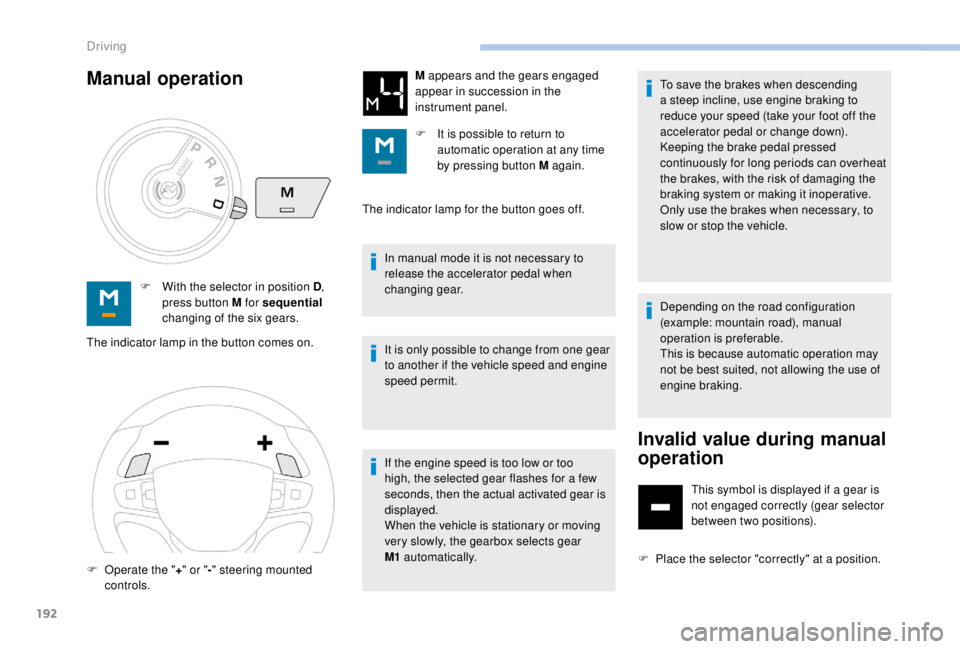
192
F With the selector in position D,
press button M for sequential
changing of the six gears.
The indicator lamp in the button comes on. The indicator lamp for the button goes off.
In manual mode it is not necessary to
release the accelerator pedal when
changing gear.
It is only possible to change from one gear
to another if the vehicle speed and engine
speed permit.
If the engine speed is too low or too
high, the selected gear flashes for a few
seconds, then the actual activated gear is
displayed.
When the vehicle is stationary or moving
very slowly, the gearbox selects gear
M1
automatically.To save the brakes when descending
a steep incline, use engine braking to
reduce your speed (take your foot off the
accelerator pedal or change down).
Keeping the brake pedal pressed
continuously for long periods can overheat
the brakes, with the risk of damaging the
braking system or making it inoperative.
Only use the brakes when necessary, to
slow or stop the vehicle.
Depending on the road configuration
(example: mountain road), manual
operation is preferable.
This is because automatic operation may
not be best suited, not allowing the use of
engine braking.
Invalid value during manual
operation
This symbol is displayed if a gear is
not engaged correctly (gear selector
between two positions).
F
P
lace the selector "correctly" at a position.
Manual operationM appears and the gears engaged
appear in succession in the
instrument panel.
F
I
t is possible to return to
automatic operation at any time
by pressing button M again.
F
O
perate the " +" or " -" steering mounted
controls.
Driving
Page 196 of 416

194
Electronic gearbox
Electronically controlled gearbox which offers
a choice between the comfort of fully automatic
operation and manual gear changing.
Two driving modes are available:
-
a
utomatic operation for automatic control
of the gears by the gearbox, without any
action on the part of the driver,
-
man
ual operation for sequential gear
changing by the driver using the steering
mounted paddles.
With automatic operation, you can temporarily
take over control of gear changing at any time.
Gear selector
To safely switch the gear selector, it is
recommended that you keep your foot on
the brake.
Steering mounted controls
The steering mounted paddles cannot be
used to select neutral or to select or come
out of reverse gear.
F
P
ull the right-hand "
+" control paddle
towards you to change up.
F
P
ull the left-hand "
-" control paddle towards
you to change down.
R.
Reverse.
F
T
urn the selector to this position.
N. Neutral.
F
W
ith your foot on the brake, turn the
selector to this position for starting.
A. Automatic operation.
F
T
urn the selector to this position.
M. Manual operation with sequential
changing of the gears.
F
T
urn the selector to this position, then
use the steering mounted control
paddles to change gear.
Driving